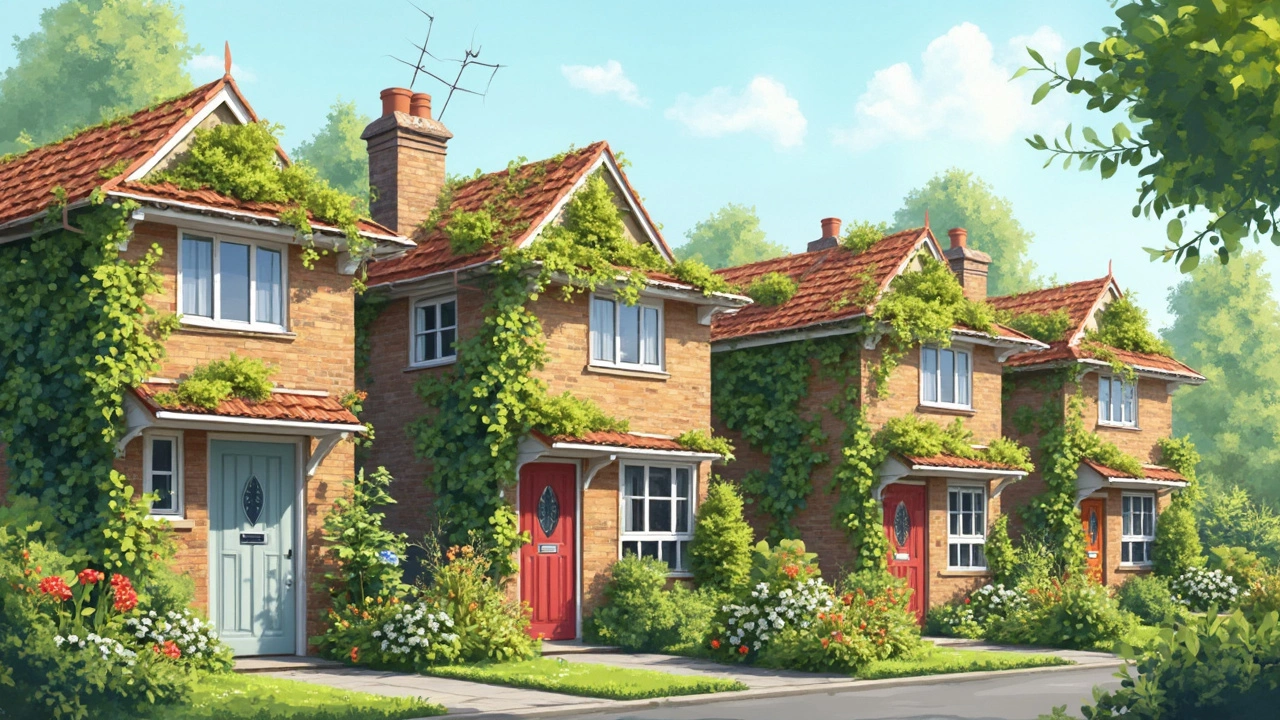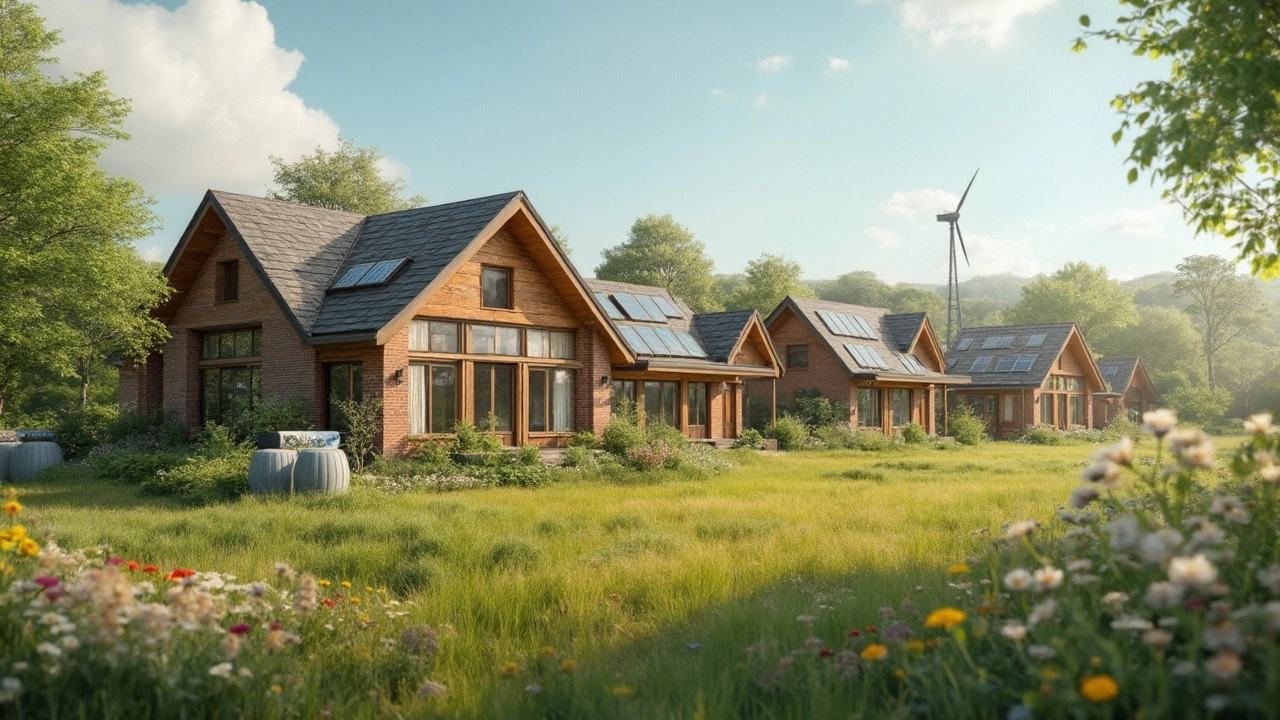Thinking about an eco-friendly cottage? It’s not just about picking a cute tiny house in the woods—what really matters is how it’s built, what it’s made from, and how it runs day to day.
If you want to shrink your impact on the planet, you’ve got to look beyond the outside. The greenest homes use materials like reclaimed wood, straw bales, or recycled steel. Skip vinyl siding and fiberglass insulation if you can—they’re tough on the environment both to make and to throw away.
The location and size matter too. Smaller cottages use less energy to heat and cool. Plus, simple designs with good insulation and big south-facing windows can cut your energy bills (and your carbon emissions) to practically zero.
Want a quick tip? Composting toilets and rainwater catchment systems are easy upgrades that make a big difference. They lower both water use and pollution, especially in off-grid cottages where every drop and watt counts.
- Defining Eco-Friendly Housing
- Top Sustainable Materials and Designs
- Real-Life Eco Cottage Examples
- Tips for Greener Living
Defining Eco-Friendly Housing
So, what actually counts as eco-friendly housing? It's not just about tossing up some solar panels or painting the walls with non-toxic paint. At its core, eco-friendly housing focuses on using resources wisely and creating as little waste and pollution as possible—both during construction and throughout the life of the home.
You’ll see a few big things that set these homes apart:
- Eco-friendly cottages and similar homes use materials that are renewable, recycled, or have low environmental impact. Think bamboo flooring instead of hardwood, or hempcrete walls instead of concrete.
- They’re designed to use less energy. Good insulation, tight windows, and natural light help cut down on heating and cooling needs.
- Water efficiency gets serious attention—low-flow toilets and showers, rainwater collection, and graywater systems all help save water.
- They cut down on what ends up in the landfill, both in building (using reclaimed or recycled stuff) and by running efficiently, so less gets replaced or thrown away over time.
Size matters, too. The smaller the house, the less material goes in, and the less energy it needs every year. You see this in tiny homes, but even regular-sized eco-cottages aim to avoid wasted space—no random rooms you never use.
Clever design makes a big difference. Putting windows and doors in the right spots, adding overhangs for shade, or building into a hillside to use the earth’s natural insulation are all tricks used in these homes.
Basically, eco-friendly housing is about cutting waste, saving energy, and making smart choices—without making life harder in the process.
Top Sustainable Materials and Designs
When you think about building an eco-friendly cottage, choosing the right materials can make or break your green goals. Some building supplies practically scream "sustainable," while others are just bad news for the planet. Let's look at the winners.
Reclaimed wood is a go-to. Rather than chopping down new trees, you give old beams, flooring, or barn wood a second life. Bamboo is another favorite—it's a grass, not a tree, so it grows crazy fast and doesn’t need much water. Straw bales, believe it or not, are top-notch for insulation and are super affordable, especially if you live in a farming area. Rammed earth and clay provide natural cooling, which pays off in hot or dry areas. For roofing, metal and recycled shingles last ages and are recyclable at the end of their life.
If you want a snapshot, check out this quick breakdown:
| Material | Main Benefit | Common Use | Environmental Impact |
|---|---|---|---|
| Reclaimed Wood | Lowers deforestation | Floors, walls, trim | Low |
| Bamboo | Super renewable | Flooring, cabinetry | Very low |
| Straw Bales | Insulation powerhouse | Walls, insulation | Very low |
| Rammed Earth | Thermal mass | Walls, foundations | Low |
| Recycled Metal | Durable, reusable | Roofs, frames | Medium |
Design is just as important as the materials. Passive solar layouts catch the sun’s heat in winter but stay cool in the summer just by being smart about window placement. Thick, well-insulated walls (think straw bale or earth) keep cottages toasty without using a ton of energy. Roof overhangs protect windows from summer sun glare but let winter rays sneak in—no fancy tech required!
“Passive design is the first step to a low energy home. Most heating and cooling can be handled by smart windows, insulation, and orientation.” — Dr. Feist, Passive House Institute
Don’t forget about finishes and fixtures. Low-VOC paints and stains keep indoor air clean. Salvaged doors and vintage lighting reduce new manufacturing waste. If you’re going off-grid, solar panels and battery storage are becoming a no-brainer for new eco cottage builds.
- Pick natural materials that last and can be reused or recycled.
- Plan your cottage to make the most of natural sunlight and airflow—no need for fancy gadgets.
- If possible, use local materials to cut down on transport emissions and support your community.
Going green isn’t just about saving energy—it's in every decision, from the ground up. Your cottage doesn’t have to be big or high-tech. The simplest homes, built right, can have the smallest footprint.

Real-Life Eco Cottage Examples
Want to see what sustainable living actually looks like? Let’s take a look at some real eco cottages that show what works in the real world.
First up, the Zero-Carbon Cottage in Kent, England, packs a punch. Built in 2022, it uses locally sourced timber, hemp insulation, and a green roof covered in wildflowers. The owners added solar panels and a rainwater collection system, so the house covers almost all its own needs. After a year, they reported using just 1,000 kilowatt-hours of electricity, way less than the UK average of 3,700 kWh a year for a regular home.
In the United States, the iconic Earthship Biotecture homes in New Mexico have gained a cult following. These off-grid cottages are built from old tires, recycled bottles, and adobe. They stay warm in winter and cool in summer thanks to thick, thermal mass walls and smart window placement. What’s cool? Earthship owners have reported slashing their utility bills down to nearly zero since the homes handle heating, cooling, and water collection all by themselves.
Across the world in Sweden, the Östergötland Strawbale Cottage went up in 2021. It’s a great example of using simple local materials—mainly straw and clay plaster—which keeps the indoor air super fresh and cuts construction emissions. It holds heat so well that it usually needs just a tiny wood stove to stay warm, even when it’s freezing outside.
Here’s a quick look at how these eco cottages compare on some key features:
| Cottage | Main Materials | Average Annual Energy Use (kWh) | Water System | Year Built |
|---|---|---|---|---|
| Zero-Carbon Cottage (UK) | Timber, hemp insulation, green roof | 1,000 | Rainwater collection | 2022 |
| Earthship (USA) | Recycled tires, bottles, adobe | ~500 | Onsite collection & filtration | Ongoing since 1990s |
| Strawbale Cottage (Sweden) | Strawbale, clay, timber | 800 | Rain catchment, compost toilet | 2021 |
What really stands out? Every one of these eco-friendly cottages saves a ton of energy compared to regular houses. Their owners get lower bills and less guilt. If you’re dreaming up your own green getaway, these proven ideas are worth borrowing.
Tips for Greener Living
If you want your place to be truly eco-friendly, what you do every day matters as much as how your cottage was built. Here's how you can level up your green game—no matter where you live.
- Eco-friendly cottages can be powered by solar panels. Even a small setup can cover lights, a fridge, and charging your phone. In sunny spots, rooftop solar can power almost everything, slashing your electric bill and carbon footprint.
- Switch to LED bulbs. According to the U.S. Department of Energy, LEDs use at least 75% less energy and last up to 25 times longer than regular bulbs. Serious savings without any fancy setup.
- Insulation is huge. Good insulation keeps warm air in during winter and out during summer, so your heating and cooling don’t have to work overtime. Think about using sheep’s wool or recycled denim—it works and it’s less polluting to make.
- Catching rainwater is easier than you think. Set up barrels under your gutters to use for plants or even flushing toilets. It's simple tech that saves serious water.
- Reuse and upcycle what you already have. Salvaged doors, windows, and flooring give your cottage character and cut down on waste.
Water use is a big deal, especially off-grid. Composting toilets use little to no water and modern models don’t smell terrible (promise). Low-flow showerheads and faucets can also save thousands of gallons a year.
Here’s a quick comparison of how much energy and water you can save by making a few simple swaps:
| Item Upgraded | Traditional Annual Use | Eco-Friendly Option Annual Use | Annual Savings |
|---|---|---|---|
| Lighting (LED vs. Incandescent) | 328 kWh (incandescent) | 65 kWh (LED) | 263 kWh |
| Shower (Standard vs. Low-flow) | 12,000 gallons | 8,000 gallons | 4,000 gallons |
| Toilet (Regular vs. Composting) | 9,000 gallons | Minimal | 8,500+ gallons |
If your spot gets cold, a wood stove can be a smart choice, especially if you use deadfall or local scrap wood. Just make sure your stove is EPA-certified to cut down on smoke and pollution.
It’s all about stacking small wins. Start with the easy stuff, like upgrading to LEDs, and keep building from there. Little changes add up fast in a small cottage, and your impact grows with every step.
